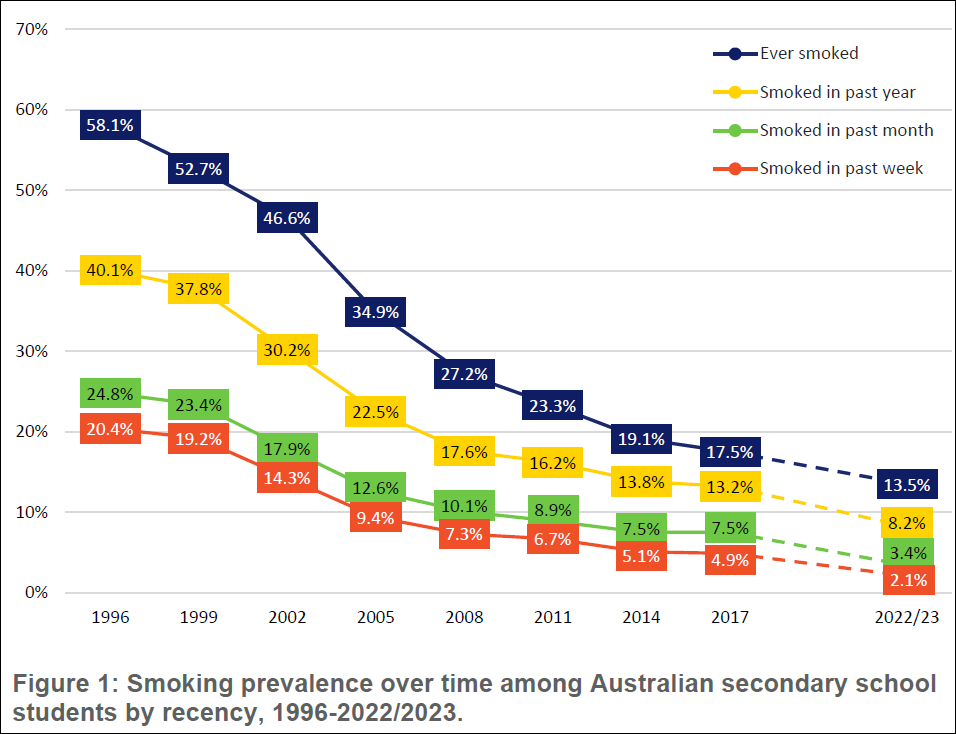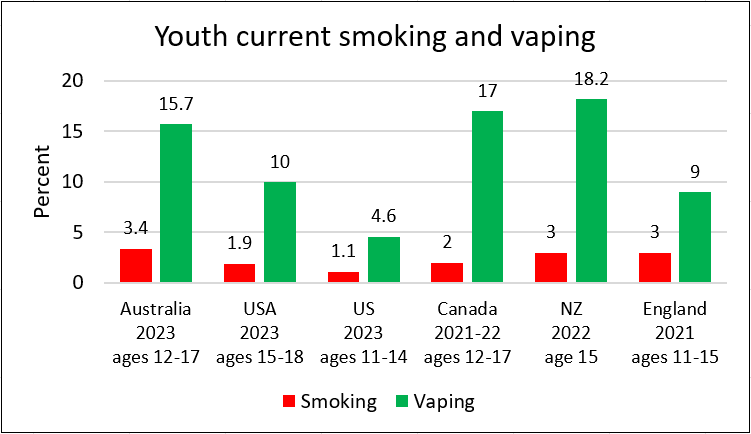
Rapid decline in youth smoking – new survey
Posted on December 22, 2023 By Colin
The Australian Secondary Students’ Alcohol and Drug Survey (ASSAD) released yesterday found that only 2.1% of 12-17-year-olds smoked in the past week in 2022-23, compared to 4.9% in the previous survey in 2017.
Youth smoking has declined by about 10% per year since the 2017 survey after vaping became popular. In comparison, the decline in smoking was 3.5% per year from 1996 to 2017.
These findings are consistent with research from other western countries showing that, rather than being a gateway to smoking, vaping is diverting young people away from deadly smoking overall

Smoking in the past week from 1996-2023 (past week smoking in red)
The survey of over 10,000 school students aged contradicts the often-repeated claims by the Health Minister that youth smoking rates are rising because of vaping
The Minister's claim was based on a Roy Morgan Survey conducted for the Department of Health and Ageing earlier this year that reported a past-month smoking rate of 12.8% among 14-17-year-olds. The Minister used this result to justify further harsh restrictions on vaping. However, the Roy Morgan survey was not credible and had methodological problems. The ASSAD study is more robust, larger and more representative of the whole population and is likely to be more accurate.
Frequent youth vaping uncommon in non-smokers
Youth vaping increased since the last survey in 2017. However, the important measure for public health is frequent vaping by non-smokers. Most vaping by non-smokers is infrequent and short-term and is of little health concern.
Only 5% of young people vaped frequently (≥20 days in the last month) and 3% vaped daily. Some of these were smokers and some did not use nicotine.
These latest figures show that youth vaping and smoking rates are similar to other western countries and are not alarmingly high as previously stated by the Health Minister. Current use means vaping or smoking once or more in the last month.

International comparisons: youth smoking and vaping
Research from the US, New Zealand and France suggests that youth vaping is a temporary fad, and the Australian figures are likely to decline after the novelty wears off.
Spin from the Cancer Council
As expected, the Cancer Council which conducted the study, tried to frame the positive results as worrying. Instead of focussing on the key public health news of a dramatic reduction in smoking, they expressed alarm at the rise in vaping (most of which was occasional), exaggerated the risks of vaping and ignored its positive role in diverting young people from deadly smoking.
Cancer Council Australia CEO, Professor Tanya Buchanan falsely claimed that vaping increases the risk of taking up smoking. However, we now know that vaping reduces smoking rates overall in youth and adults.
The Cancer Council expressed alarm at the finding of an increase in "smoking susceptibility" based on certain questions asked. This is absurd. What is important is that smoking rates are actually declining rapidly, not whether there is a theoretical increased risk in the future.
Conclusion
The findings from the ASSAD survey are good news. They confirm that youth smoking is rapidly declining in Australia. It is highly likely that vaping is contributing to this decline as it is in other countries. The Cancer Council and the Health minister need to acknowledge this instead of automatically slipping into anti-vaping panic mode.
References
Go to Top